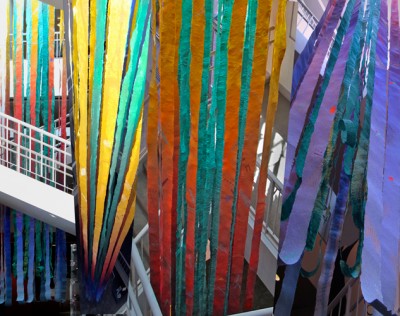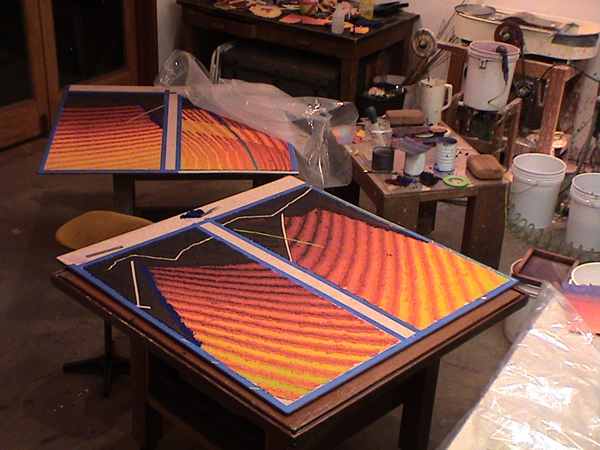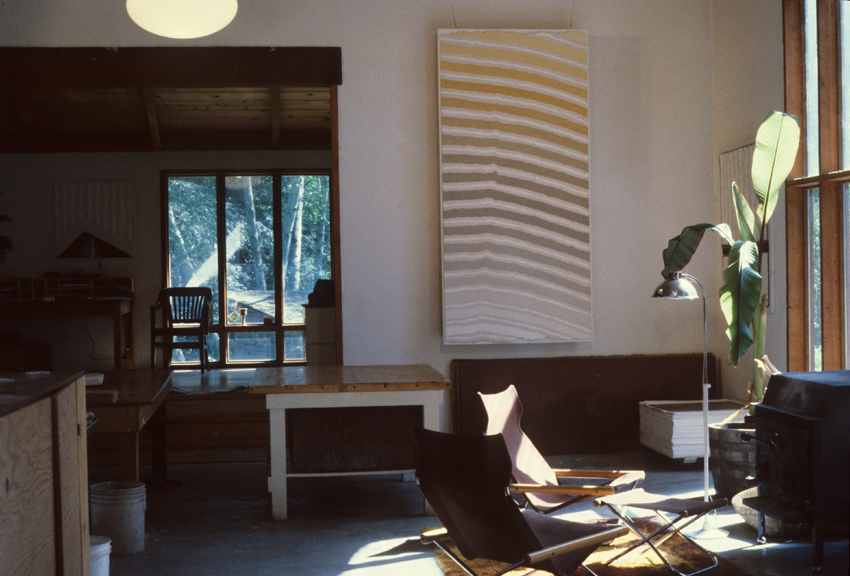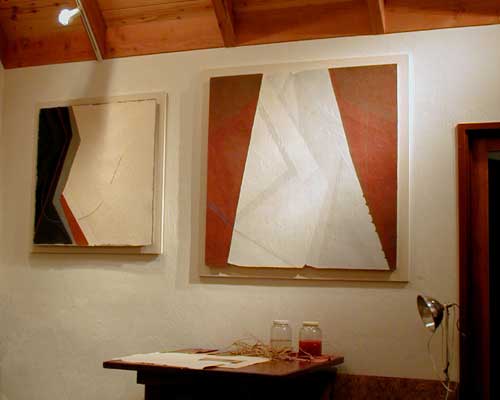 Papermaking is a fine craft, a worldwide industry of huge corporations and for me, a medium for expression. I started with the idea of making my own paper for some of the deep embossed prints that I was making in the early seventies. I recycled scraps of French rag paper left over from some large editions. What a thrill, that first sheet. I didn’t know much about paper then, but it was a start. I stopped making prints as my primary art form a few years later when the paper itself became the object.
Papermaking is a fine craft, a worldwide industry of huge corporations and for me, a medium for expression. I started with the idea of making my own paper for some of the deep embossed prints that I was making in the early seventies. I recycled scraps of French rag paper left over from some large editions. What a thrill, that first sheet. I didn’t know much about paper then, but it was a start. I stopped making prints as my primary art form a few years later when the paper itself became the object.Most all paper is made from cellulose fiber obtained from one or more of the following sources; bark, wood, seed fiber, grass, fibrous leaves or woven cloth. It is usually cooked and usually beaten, but not always. Different fibers and their preparation yield vastly different types of paper yet the same fiber prepared in a different manner can also yield different types of paper. It is the papermaker’s job to design, using his knowledge of materials and techniques, a suitable paper for his end use.
Although I’ve always made some sheets in the traditional way with a vat of pulp, and a mould and a deckle, my main interest when I was starting out was using the pulp much like clay, laying out thick flat slabs of earth colored pulp on plastic surfaces and manipulating them while they were wet, then left to dry. This was a process I named free-casting. The pulp was cast without a mould. Over a period of years, more color was introduced to the pulp and other fibers added to my repertoire. Many new techniques of pulp manipulation have been developed over the years.
 The paper that I make for my artwork is made from cotton, a seed fiber, abaca, from the stalk of a certain banana tree; and kozo, from the bark of the mulberry tree. I have found that different fibered papers reflect and absorb light in dissimilar ways so I combine dissimilar fibers to take advantage of these inherent qualities when I am building an art piece of paper. The pulp is prepared by mixing the fiber in water in various mixers or beaters in the studio. The natural pulp is then pigmented with artists’ pigment in the mixer. These batches are in turn, intermixed to a specific hue. It is not unusual to have more than fifty colors mixed for a specific artwork. Then on large flat surfaces in the studio the colored pulps of various types are manipulated and the art piece is built step by step. Sometimes large 48-60 inch sheets are poured and collaged together so that the finished piece is multiple layers of multi-colored, multi-fibered sheets All these various techniques are just tools to build a pattern of reflected light and document my visual ideas in colored paper.
The paper that I make for my artwork is made from cotton, a seed fiber, abaca, from the stalk of a certain banana tree; and kozo, from the bark of the mulberry tree. I have found that different fibered papers reflect and absorb light in dissimilar ways so I combine dissimilar fibers to take advantage of these inherent qualities when I am building an art piece of paper. The pulp is prepared by mixing the fiber in water in various mixers or beaters in the studio. The natural pulp is then pigmented with artists’ pigment in the mixer. These batches are in turn, intermixed to a specific hue. It is not unusual to have more than fifty colors mixed for a specific artwork. Then on large flat surfaces in the studio the colored pulps of various types are manipulated and the art piece is built step by step. Sometimes large 48-60 inch sheets are poured and collaged together so that the finished piece is multiple layers of multi-colored, multi-fibered sheets All these various techniques are just tools to build a pattern of reflected light and document my visual ideas in colored paper. personal discoveries of light and paper
In 1982 I was asked to show in the Papermaking USA show organized by the American Craft Museum in New York. I used my “free-cast” technique to make the piece “Heavens Ladder”, a four-foot by eight-foot sheet of abaca and cotton stripes, and this time using a subtle gradation from white to light ochre. I found a value shift on the cotton produced a change of focus in the piece as well as producing a glow within the cotton field of color just as the original tablets seemed to float because of its reaction the translucent abaca. I continued to work with these simple earth tone striated pieces for two more years.

I have always used artists’ grade dry pigments for color. I switched suppliers in 1984 and started using more saturated colors in my paper works using several different color fields within one piece. It was at this time I realized I could create hidden images within the pieces. I started to create patterns of black on black with the cotton and abaca pulps that would appear and disappear as the viewer moved past the piece. One of these works was the ladder piece “Descending Angel” which was selected for the show Poetry of the Physical put together by The American Craft Museum. There were four paper artists selected for this show showcasing American craft. It toured the US for several years.
 One of the most ambitious projects was “Near is Far and Far is Near” A five foot square paperwork completed in 1989 that was built with patterns that drift in and out as the light changes. The entire piece is a series of hidden images.
One of the most ambitious projects was “Near is Far and Far is Near” A five foot square paperwork completed in 1989 that was built with patterns that drift in and out as the light changes. The entire piece is a series of hidden images.